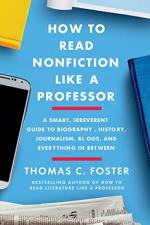
|
| Name: _________________________ | Period: ___________________ |
This quiz consists of 5 multiple choice and 5 short answer questions through Section 2: Chapter 5, "It May Just Be Me, But..." through Chapter 8, "Bringing the News".
Multiple Choice Questions
1. In Chapter 5, "It May Just Be Me, But..." Foster says that a source's quote can be "emended" (55). What happens to an emended quote?
(a) It is updated.
(b) It is verified.
(c) It is shortened.
(d) It is withdrawn.
2. In Chapter 7, "All in How You Look at Things," Foster discusses Pollan's How to Change Your Mind as an example of what?
(a) Science writing that begins in media res.
(b) Why self-help books are better off using a chronological structure.
(c) Why self-help books can use many non-chronological structures.
(d) Science writing that does not use chronological order.
3. In Chapter 2, "The Ecology of the Nonfiction Biosphere," what does Foster say is true of the sports section?
(a) Its box scores are an example of soft news.
(b) It excludes features.
(c) It contains primarily editorial columns.
(d) It contains every type of writing found in a newspaper.
4. According to Chapter 8, "Bringing the News," at what level are most news stories written?
(a) The twelfth grade level.
(b) The ninth to eleventh grade levels.
(c) The college sophomore level.
(d) The fourth to sixth grade levels.
5. In Chapter 6, "Source Code,"what does Foster say about researching primary sources on microfiche?
(a) Microfiche is obsolete and has already been supplanted by digital sources.
(b) It's too much work.
(c) Microfiche is an unreliable medium.
(d) It may be tedious, but it's worth the effort.
Short Answer Questions
1. In Chapter 6, "Source Code," Foster talks about the change in value over time of a reporter's eyewitness testimony. What does Foster call this change in value?
2. In Chapter 3, "The Power of the Prologue," what does Foster give as the basic meaning of "preface," "prologue," and "foreward"?
3. In Chapter 6, "Source Code," what consequence does Foster say the rise of the internet has had?
4. In Chapter 2, "The Ecology of the Nonfiction Biosphere," Foster calls an expression a "bromide." What is he saying about this expression?
5. In Chapter 2, "The Ecology of the Nonfiction Biosphere," what implicit assertion about online writing does Foster make?
|
This section contains 438 words (approx. 2 pages at 300 words per page) |

|




